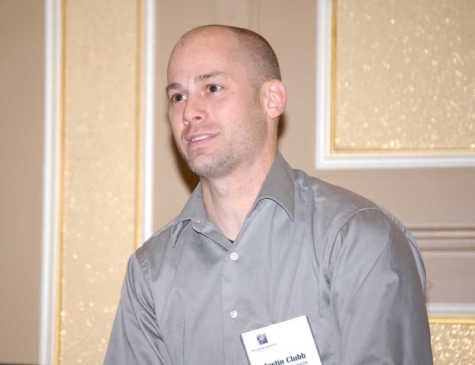Collision repairers sometimes grouse about the auto body shop training programs at schools in their area. But Justin Clubb didn’t just complain. He did something about it.
Speaking as part of a panel discussion at the Collision Industry Conference (CIC) on Nov. 2 in Las Vegas, Clubb, general manager of Deery Collision Center in Burlington, IA, said he’d served for some time on the advisory council for the collision program at nearby Southeastern Community College. He came to realize, however, the program seemed to be more about “restoration” and “working on stuff that is not relevant to the collision industry.”
When the school announced a new dean, Ashlee Spannagel, for its career and technical education programs, Clubb asked to meet with her. Spannagel told CIC attendees at the meeting she previously knew nothing about the collision repair industry other than being “a frequent flier of Campbell's Auto Body, because I kept running into things.”
But she had concerns of her own about the collision program when in response to her own question at an advisory council meeting, she was told “OSHA didn’t apply to the industry.”
“I knew nothing, but I did know enough that OSHA did apply,” Spannagel said. “That was the biggest thing I had to do as a leader and educator, to figure out how to not be so ignorant about this industry,” even while overseeing dozens of other degree and certificate programs at the school as well.
Clubb spent a lot of time working with Spannagel, and helped connect her with contacts at I-CAR, Tradiebot, the Collision Repair Education Foundation (CREF) and the ASE Education Foundation.
Along with faculty and other volunteers, the two spent hours moving and sorting through dozens of totes of tools and supplies stored in the program’s shop, including 3,000 rolls of electrical tape, and more than 12 pallets of bulk tools.
“If you need 800 10-millimieter wrenches, I am your girl. I know where they are,” Spannagel said, soliciting laughter from CIC attendees.
About 18 months later, she said, their combined efforts have “completely transformed” the school’s collision repair program.
“We now have invested over $500,000 into a state of the art facility,” Spannagel said. “We now have a relationship with the industry. The industry before was specifically telling us that our students were not what they needed, but in some cases, we simply weren’t listening. We are listening now. We are acting now. We are changing as a result of that. We are undergoing a curriculum revision right now. As a result, we will have better qualified students, more well-equipped students, and more students in the future.”
Clubb and Spannagel agreed such a turnaround requires the buy-in---and “hundreds of hours” of work---by faculty and the industry, but Clubb especially credited Spannagel’s outlook and commitment.
“Teach me what I need to know, so that we can move forward and serve our local communities the way community colleges were designed to do,” Spannagel said, drawing applause at CIC.
Lidar coming to a car near you soon
Another panel discussion at CIC focused on how lidar works as part of a vehicle’s advanced driver assistance systems, and what collision repairers will need to know about the technology.
General Motors, Lucid and Volvo have announced some new vehicles in 2022 and 2023 will include lidar.
“Most of the major manufacturers have a desire to put lidar on their vehicles by 2024 or 2025,” said Cibby Pulikkaseril, chief technology officer and co-founder of Baraja, an Australian company developing lidar systems. “It will be a major trend in automotive.”
Whether positioned at the front roof line, behind the windshield or within the grill or headlamps, lidar needs a surface in front of it that is clean and free of abrasions.
“Definitely paint is something you’d never put over the lidar,” Pulikkaseril said.
Typical laminated windshields are designed to block the type of infrared lasers used in lidar systems, so any replacement windshield installed in a vehicle with windshield-mounted lidar will need to meet the proper specifications, including related to tinting.
“The windshields have to be designed for lidar transmissivity, so you would not be able to just replace it with any other windshield,” he said. “You’d need to get the specified one.”
Abrasions from road debris or other sources to the windshield or other glass in front of lidar will also obscure the system’s “view” of the road ahead.
“I think what you’ll see is that many of the lidars mounted to the vehicle will have ‘obscure detection,’ so it will self-report that the windshield, or whatever the lidar is going through, has stopped transmitting,” Pulikkaseril said.
Upcoming CIC meetings
Citing the stricter COVID-related restrictions in place in Palm Springs, CA, CIC organizers announced in November the January CIC will instead be held in Phoenix, AZ. Details are available at the CIC website.
One topic that may be on the agenda: the disruptions in the global parts supply chain.
Aaron Schulenburg ended the Parts and Materials Committee session in Las Vegas by polling meeting attendees about whether they currently see parts delays as an issue---90% said yes---and whether they wanted “supply chain disruptions” to be a topic the committee explores at future meetings.

Aaron Schulenburg
When the committee asked that same question last April, fewer than half---44%---of CIC attendees said yes. But in Las Vegas in November, nearly twice that percentage---83%---answered affirmatively, clearly an indication of changed business conditions in recent months.
“I don’t think it was a big enough issue when we asked the first time, but I think it is now, and that’s obviously reflected in the response,” Schulenburg said.










John Yoswick